Reflexive Practitioner Development Project: Management Studies
VerifiedAdded on 2022/08/23
|17
|3547
|42
Project
AI Summary
This project focuses on the development of a reflexive practitioner, specifically within a management context. It explores the importance of self-awareness, professional development, and the ability to adapt to rapid changes in the business environment. The research utilizes a causal research design, incorporating a bricolage approach with art-based methodologies like storyboards to combine the Johari window and CIPD model for behavioral analysis. The project aims to increase self-awareness among practitioners, exploring tools such as the Johari window and CIPD model to understand individual relationships and behaviors within a management setting. The project also includes a digital storyboard illustrating key concepts and real-life scenarios, offering practical insights into the challenges and solutions for reflexive practitioners. The project highlights the need for continuous professional development and adaptation to ensure managers are prepared for the complexities of their roles.
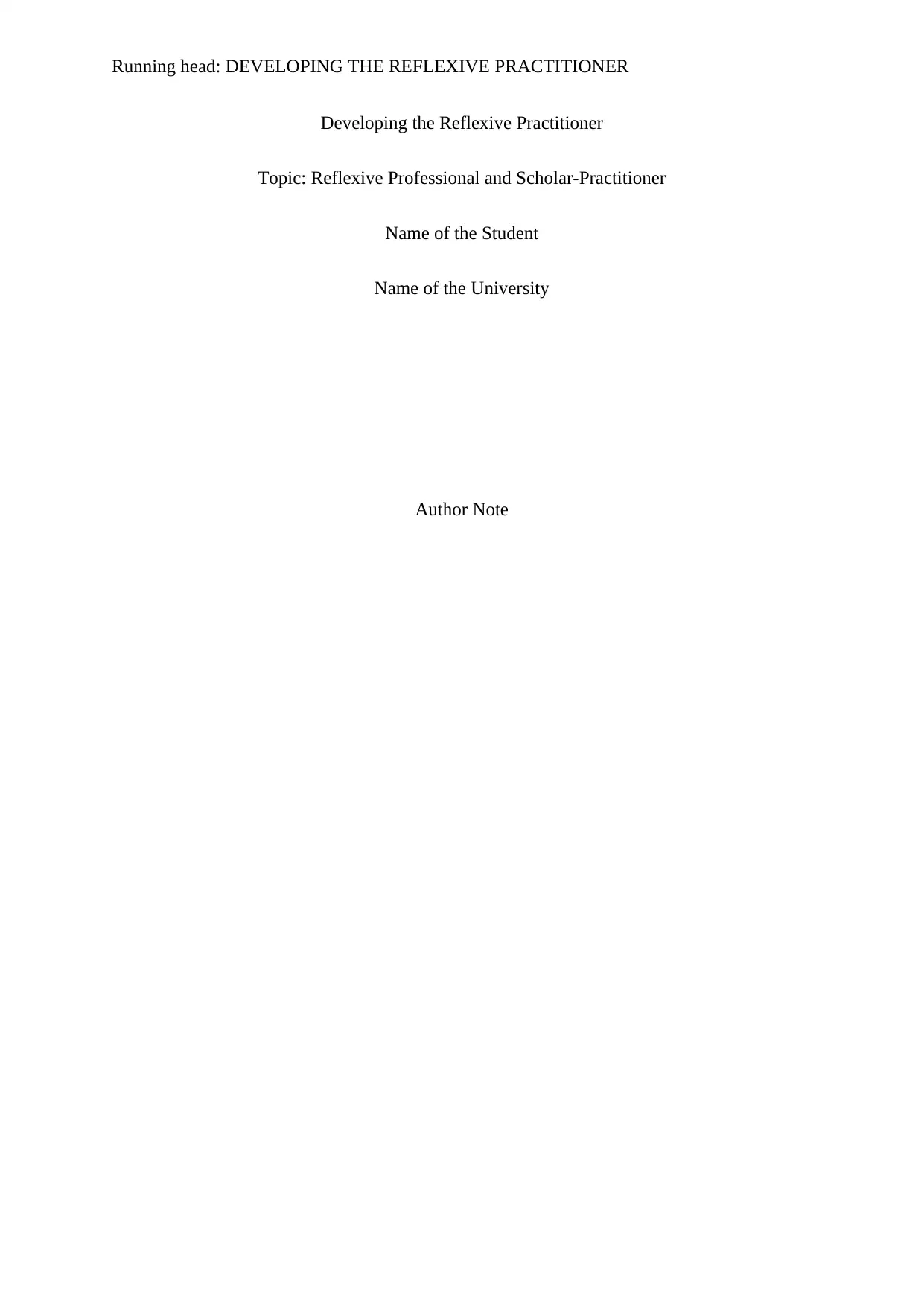
Running head: DEVELOPING THE REFLEXIVE PRACTITIONER
Developing the Reflexive Practitioner
Topic: Reflexive Professional and Scholar-Practitioner
Name of the Student
Name of the University
Author Note
Developing the Reflexive Practitioner
Topic: Reflexive Professional and Scholar-Practitioner
Name of the Student
Name of the University
Author Note
Paraphrase This Document
Need a fresh take? Get an instant paraphrase of this document with our AI Paraphraser
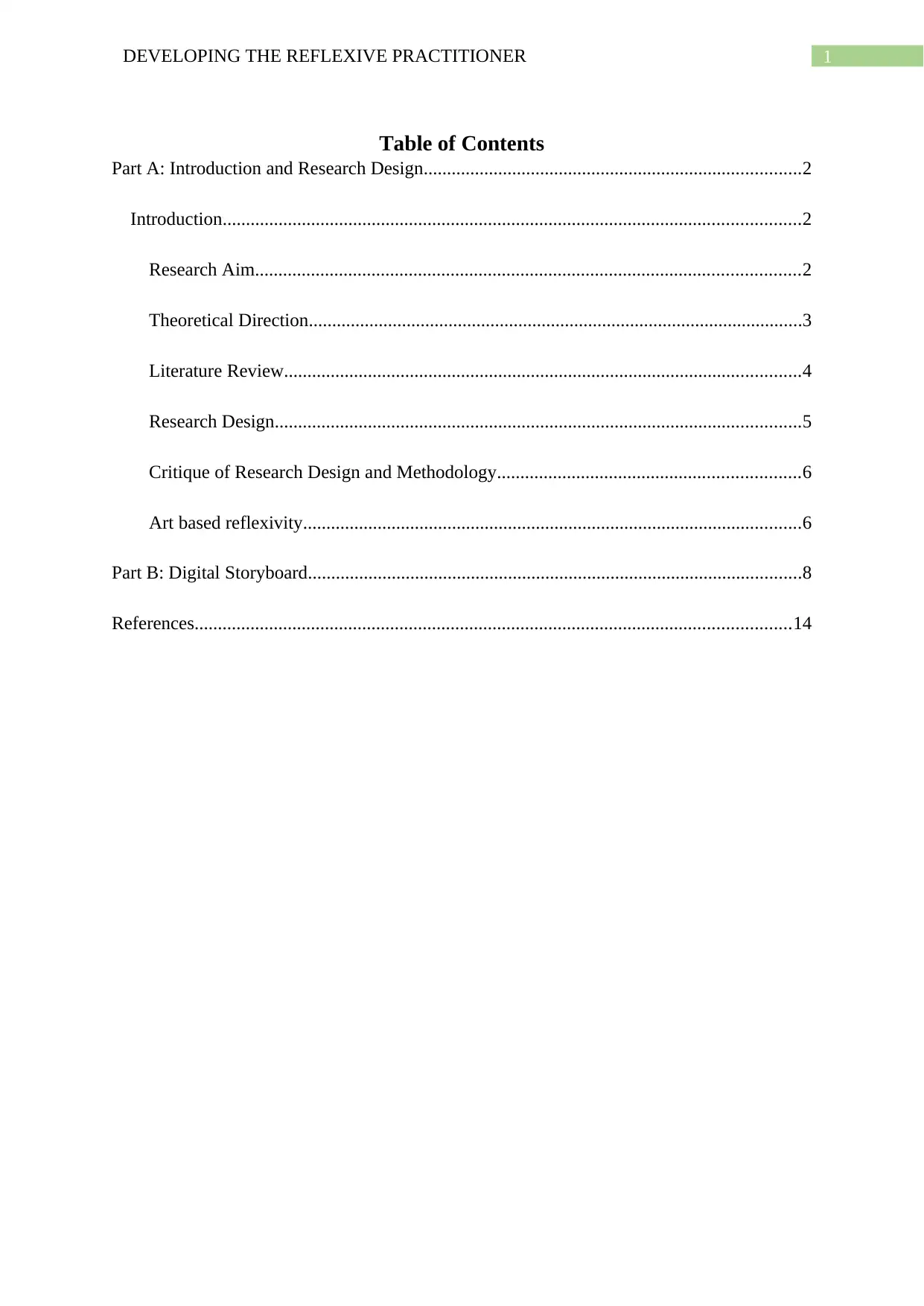
1DEVELOPING THE REFLEXIVE PRACTITIONER
Table of Contents
Part A: Introduction and Research Design.................................................................................2
Introduction............................................................................................................................2
Research Aim.....................................................................................................................2
Theoretical Direction..........................................................................................................3
Literature Review...............................................................................................................4
Research Design.................................................................................................................5
Critique of Research Design and Methodology.................................................................6
Art based reflexivity...........................................................................................................6
Part B: Digital Storyboard..........................................................................................................8
References................................................................................................................................14
Table of Contents
Part A: Introduction and Research Design.................................................................................2
Introduction............................................................................................................................2
Research Aim.....................................................................................................................2
Theoretical Direction..........................................................................................................3
Literature Review...............................................................................................................4
Research Design.................................................................................................................5
Critique of Research Design and Methodology.................................................................6
Art based reflexivity...........................................................................................................6
Part B: Digital Storyboard..........................................................................................................8
References................................................................................................................................14
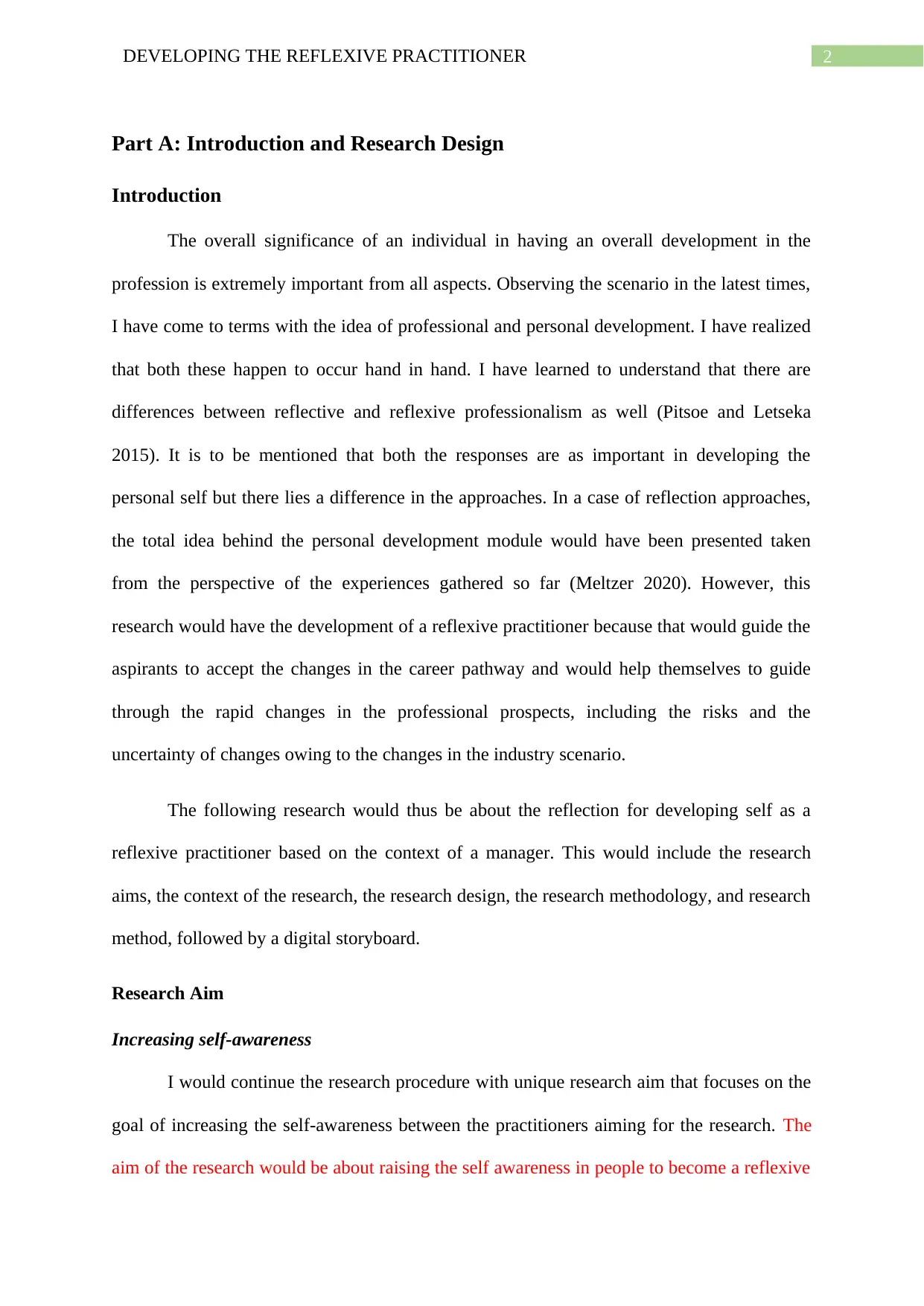
2DEVELOPING THE REFLEXIVE PRACTITIONER
Part A: Introduction and Research Design
Introduction
The overall significance of an individual in having an overall development in the
profession is extremely important from all aspects. Observing the scenario in the latest times,
I have come to terms with the idea of professional and personal development. I have realized
that both these happen to occur hand in hand. I have learned to understand that there are
differences between reflective and reflexive professionalism as well (Pitsoe and Letseka
2015). It is to be mentioned that both the responses are as important in developing the
personal self but there lies a difference in the approaches. In a case of reflection approaches,
the total idea behind the personal development module would have been presented taken
from the perspective of the experiences gathered so far (Meltzer 2020). However, this
research would have the development of a reflexive practitioner because that would guide the
aspirants to accept the changes in the career pathway and would help themselves to guide
through the rapid changes in the professional prospects, including the risks and the
uncertainty of changes owing to the changes in the industry scenario.
The following research would thus be about the reflection for developing self as a
reflexive practitioner based on the context of a manager. This would include the research
aims, the context of the research, the research design, the research methodology, and research
method, followed by a digital storyboard.
Research Aim
Increasing self-awareness
I would continue the research procedure with unique research aim that focuses on the
goal of increasing the self-awareness between the practitioners aiming for the research. The
aim of the research would be about raising the self awareness in people to become a reflexive
Part A: Introduction and Research Design
Introduction
The overall significance of an individual in having an overall development in the
profession is extremely important from all aspects. Observing the scenario in the latest times,
I have come to terms with the idea of professional and personal development. I have realized
that both these happen to occur hand in hand. I have learned to understand that there are
differences between reflective and reflexive professionalism as well (Pitsoe and Letseka
2015). It is to be mentioned that both the responses are as important in developing the
personal self but there lies a difference in the approaches. In a case of reflection approaches,
the total idea behind the personal development module would have been presented taken
from the perspective of the experiences gathered so far (Meltzer 2020). However, this
research would have the development of a reflexive practitioner because that would guide the
aspirants to accept the changes in the career pathway and would help themselves to guide
through the rapid changes in the professional prospects, including the risks and the
uncertainty of changes owing to the changes in the industry scenario.
The following research would thus be about the reflection for developing self as a
reflexive practitioner based on the context of a manager. This would include the research
aims, the context of the research, the research design, the research methodology, and research
method, followed by a digital storyboard.
Research Aim
Increasing self-awareness
I would continue the research procedure with unique research aim that focuses on the
goal of increasing the self-awareness between the practitioners aiming for the research. The
aim of the research would be about raising the self awareness in people to become a reflexive
⊘ This is a preview!⊘
Do you want full access?
Subscribe today to unlock all pages.

Trusted by 1+ million students worldwide
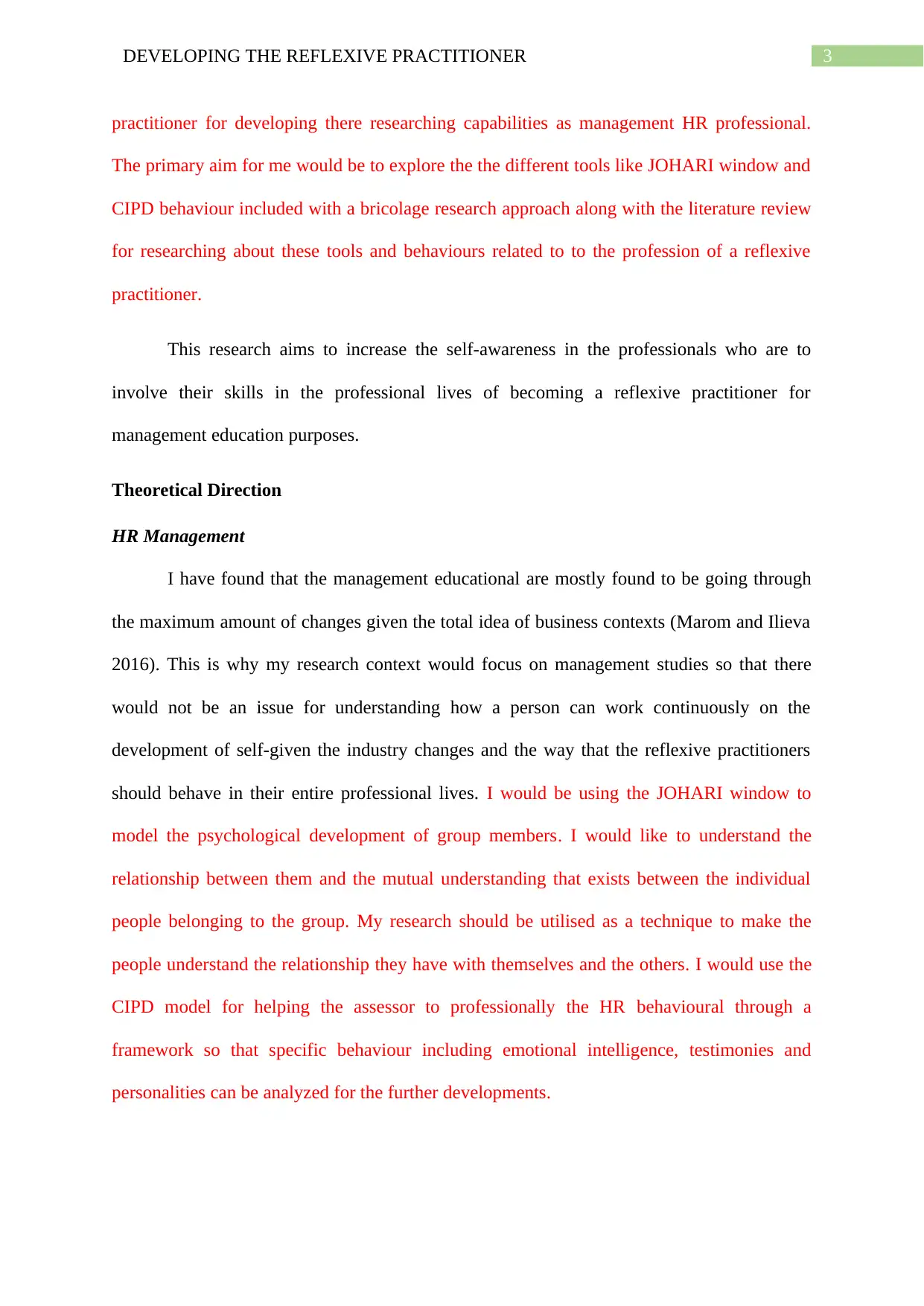
3DEVELOPING THE REFLEXIVE PRACTITIONER
practitioner for developing there researching capabilities as management HR professional.
The primary aim for me would be to explore the the different tools like JOHARI window and
CIPD behaviour included with a bricolage research approach along with the literature review
for researching about these tools and behaviours related to to the profession of a reflexive
practitioner.
This research aims to increase the self-awareness in the professionals who are to
involve their skills in the professional lives of becoming a reflexive practitioner for
management education purposes.
Theoretical Direction
HR Management
I have found that the management educational are mostly found to be going through
the maximum amount of changes given the total idea of business contexts (Marom and Ilieva
2016). This is why my research context would focus on management studies so that there
would not be an issue for understanding how a person can work continuously on the
development of self-given the industry changes and the way that the reflexive practitioners
should behave in their entire professional lives. I would be using the JOHARI window to
model the psychological development of group members. I would like to understand the
relationship between them and the mutual understanding that exists between the individual
people belonging to the group. My research should be utilised as a technique to make the
people understand the relationship they have with themselves and the others. I would use the
CIPD model for helping the assessor to professionally the HR behavioural through a
framework so that specific behaviour including emotional intelligence, testimonies and
personalities can be analyzed for the further developments.
practitioner for developing there researching capabilities as management HR professional.
The primary aim for me would be to explore the the different tools like JOHARI window and
CIPD behaviour included with a bricolage research approach along with the literature review
for researching about these tools and behaviours related to to the profession of a reflexive
practitioner.
This research aims to increase the self-awareness in the professionals who are to
involve their skills in the professional lives of becoming a reflexive practitioner for
management education purposes.
Theoretical Direction
HR Management
I have found that the management educational are mostly found to be going through
the maximum amount of changes given the total idea of business contexts (Marom and Ilieva
2016). This is why my research context would focus on management studies so that there
would not be an issue for understanding how a person can work continuously on the
development of self-given the industry changes and the way that the reflexive practitioners
should behave in their entire professional lives. I would be using the JOHARI window to
model the psychological development of group members. I would like to understand the
relationship between them and the mutual understanding that exists between the individual
people belonging to the group. My research should be utilised as a technique to make the
people understand the relationship they have with themselves and the others. I would use the
CIPD model for helping the assessor to professionally the HR behavioural through a
framework so that specific behaviour including emotional intelligence, testimonies and
personalities can be analyzed for the further developments.
Paraphrase This Document
Need a fresh take? Get an instant paraphrase of this document with our AI Paraphraser
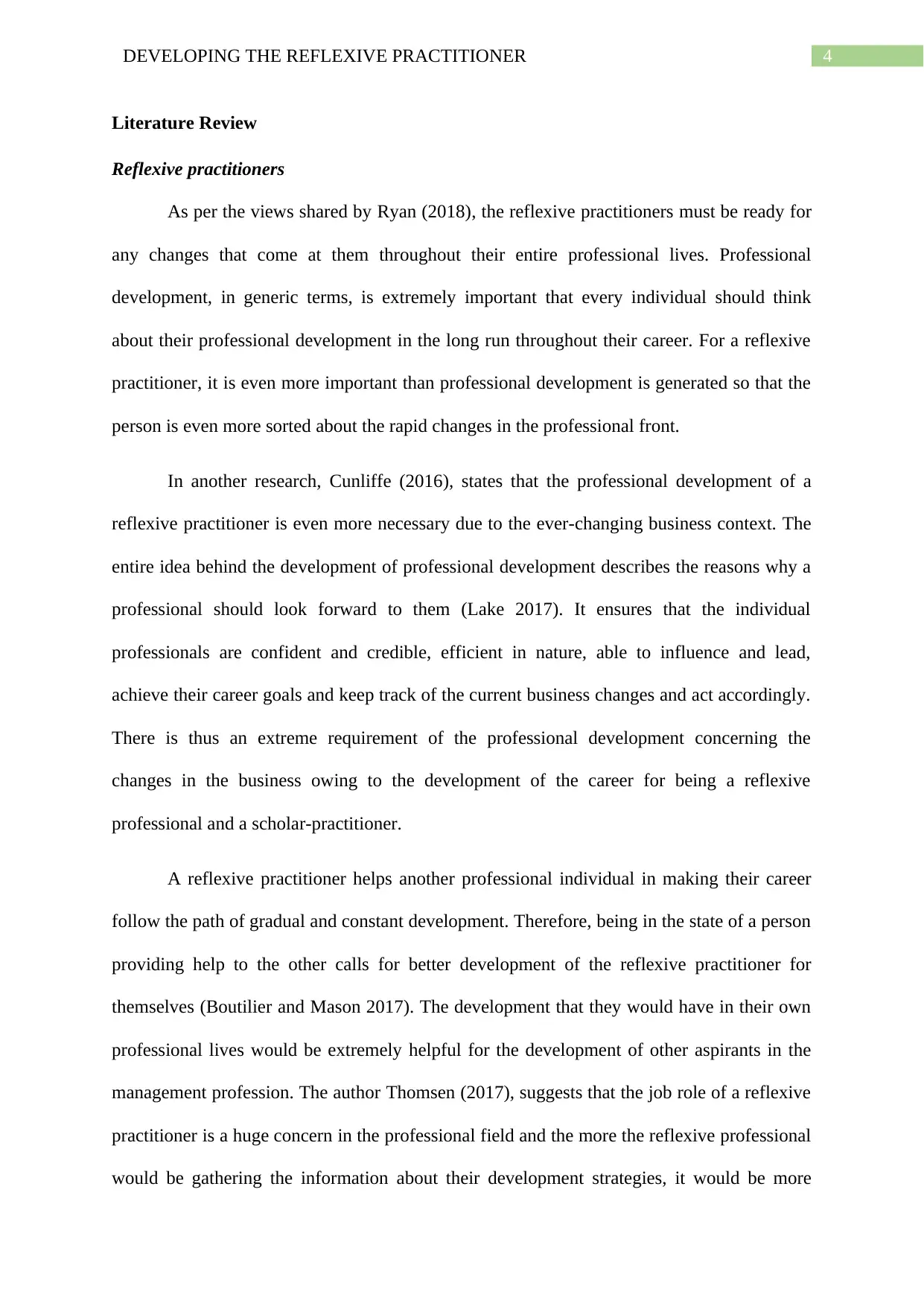
4DEVELOPING THE REFLEXIVE PRACTITIONER
Literature Review
Reflexive practitioners
As per the views shared by Ryan (2018), the reflexive practitioners must be ready for
any changes that come at them throughout their entire professional lives. Professional
development, in generic terms, is extremely important that every individual should think
about their professional development in the long run throughout their career. For a reflexive
practitioner, it is even more important than professional development is generated so that the
person is even more sorted about the rapid changes in the professional front.
In another research, Cunliffe (2016), states that the professional development of a
reflexive practitioner is even more necessary due to the ever-changing business context. The
entire idea behind the development of professional development describes the reasons why a
professional should look forward to them (Lake 2017). It ensures that the individual
professionals are confident and credible, efficient in nature, able to influence and lead,
achieve their career goals and keep track of the current business changes and act accordingly.
There is thus an extreme requirement of the professional development concerning the
changes in the business owing to the development of the career for being a reflexive
professional and a scholar-practitioner.
A reflexive practitioner helps another professional individual in making their career
follow the path of gradual and constant development. Therefore, being in the state of a person
providing help to the other calls for better development of the reflexive practitioner for
themselves (Boutilier and Mason 2017). The development that they would have in their own
professional lives would be extremely helpful for the development of other aspirants in the
management profession. The author Thomsen (2017), suggests that the job role of a reflexive
practitioner is a huge concern in the professional field and the more the reflexive professional
would be gathering the information about their development strategies, it would be more
Literature Review
Reflexive practitioners
As per the views shared by Ryan (2018), the reflexive practitioners must be ready for
any changes that come at them throughout their entire professional lives. Professional
development, in generic terms, is extremely important that every individual should think
about their professional development in the long run throughout their career. For a reflexive
practitioner, it is even more important than professional development is generated so that the
person is even more sorted about the rapid changes in the professional front.
In another research, Cunliffe (2016), states that the professional development of a
reflexive practitioner is even more necessary due to the ever-changing business context. The
entire idea behind the development of professional development describes the reasons why a
professional should look forward to them (Lake 2017). It ensures that the individual
professionals are confident and credible, efficient in nature, able to influence and lead,
achieve their career goals and keep track of the current business changes and act accordingly.
There is thus an extreme requirement of the professional development concerning the
changes in the business owing to the development of the career for being a reflexive
professional and a scholar-practitioner.
A reflexive practitioner helps another professional individual in making their career
follow the path of gradual and constant development. Therefore, being in the state of a person
providing help to the other calls for better development of the reflexive practitioner for
themselves (Boutilier and Mason 2017). The development that they would have in their own
professional lives would be extremely helpful for the development of other aspirants in the
management profession. The author Thomsen (2017), suggests that the job role of a reflexive
practitioner is a huge concern in the professional field and the more the reflexive professional
would be gathering the information about their development strategies, it would be more
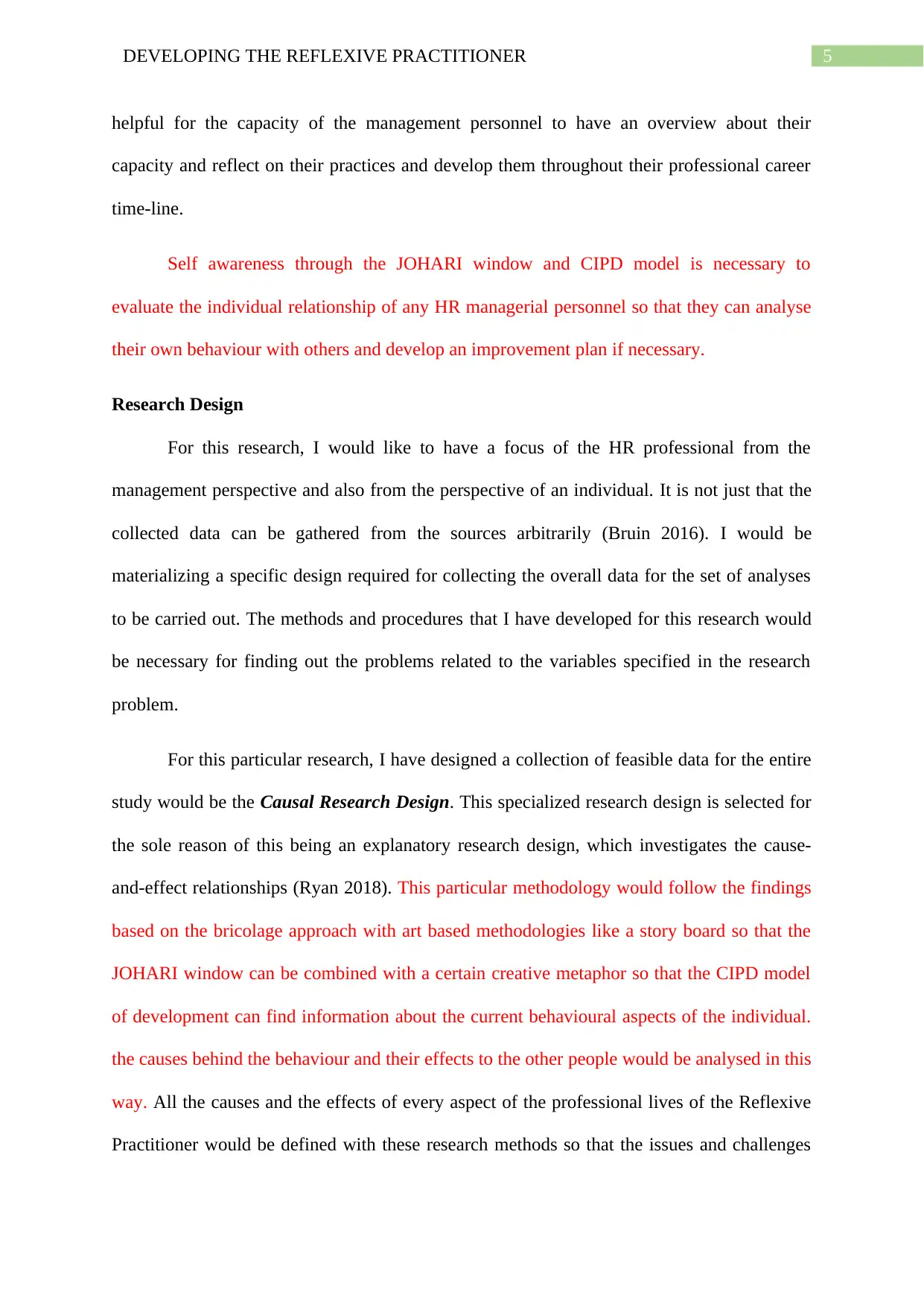
5DEVELOPING THE REFLEXIVE PRACTITIONER
helpful for the capacity of the management personnel to have an overview about their
capacity and reflect on their practices and develop them throughout their professional career
time-line.
Self awareness through the JOHARI window and CIPD model is necessary to
evaluate the individual relationship of any HR managerial personnel so that they can analyse
their own behaviour with others and develop an improvement plan if necessary.
Research Design
For this research, I would like to have a focus of the HR professional from the
management perspective and also from the perspective of an individual. It is not just that the
collected data can be gathered from the sources arbitrarily (Bruin 2016). I would be
materializing a specific design required for collecting the overall data for the set of analyses
to be carried out. The methods and procedures that I have developed for this research would
be necessary for finding out the problems related to the variables specified in the research
problem.
For this particular research, I have designed a collection of feasible data for the entire
study would be the Causal Research Design. This specialized research design is selected for
the sole reason of this being an explanatory research design, which investigates the cause-
and-effect relationships (Ryan 2018). This particular methodology would follow the findings
based on the bricolage approach with art based methodologies like a story board so that the
JOHARI window can be combined with a certain creative metaphor so that the CIPD model
of development can find information about the current behavioural aspects of the individual.
the causes behind the behaviour and their effects to the other people would be analysed in this
way. All the causes and the effects of every aspect of the professional lives of the Reflexive
Practitioner would be defined with these research methods so that the issues and challenges
helpful for the capacity of the management personnel to have an overview about their
capacity and reflect on their practices and develop them throughout their professional career
time-line.
Self awareness through the JOHARI window and CIPD model is necessary to
evaluate the individual relationship of any HR managerial personnel so that they can analyse
their own behaviour with others and develop an improvement plan if necessary.
Research Design
For this research, I would like to have a focus of the HR professional from the
management perspective and also from the perspective of an individual. It is not just that the
collected data can be gathered from the sources arbitrarily (Bruin 2016). I would be
materializing a specific design required for collecting the overall data for the set of analyses
to be carried out. The methods and procedures that I have developed for this research would
be necessary for finding out the problems related to the variables specified in the research
problem.
For this particular research, I have designed a collection of feasible data for the entire
study would be the Causal Research Design. This specialized research design is selected for
the sole reason of this being an explanatory research design, which investigates the cause-
and-effect relationships (Ryan 2018). This particular methodology would follow the findings
based on the bricolage approach with art based methodologies like a story board so that the
JOHARI window can be combined with a certain creative metaphor so that the CIPD model
of development can find information about the current behavioural aspects of the individual.
the causes behind the behaviour and their effects to the other people would be analysed in this
way. All the causes and the effects of every aspect of the professional lives of the Reflexive
Practitioner would be defined with these research methods so that the issues and challenges
⊘ This is a preview!⊘
Do you want full access?
Subscribe today to unlock all pages.

Trusted by 1+ million students worldwide
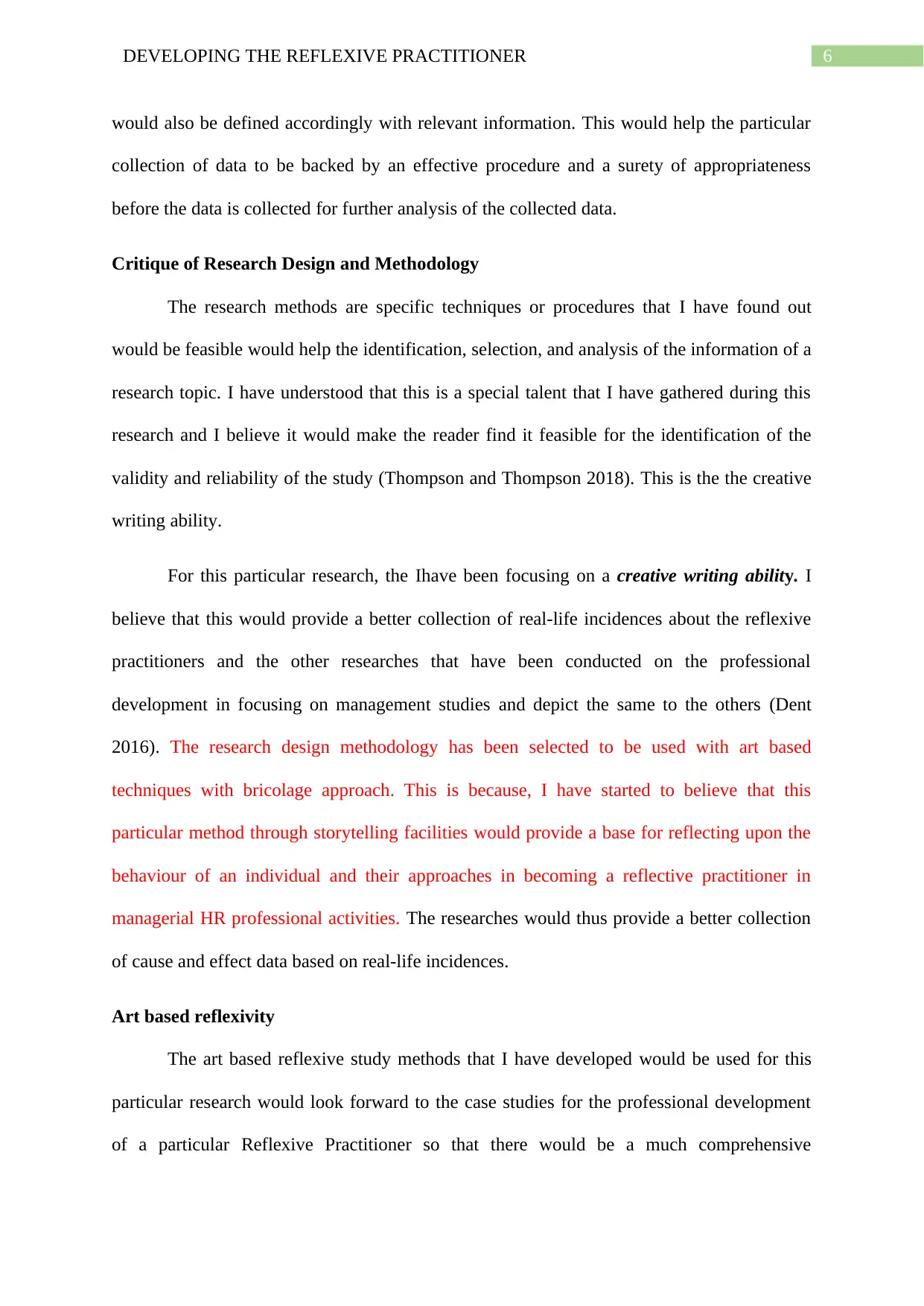
6DEVELOPING THE REFLEXIVE PRACTITIONER
would also be defined accordingly with relevant information. This would help the particular
collection of data to be backed by an effective procedure and a surety of appropriateness
before the data is collected for further analysis of the collected data.
Critique of Research Design and Methodology
The research methods are specific techniques or procedures that I have found out
would be feasible would help the identification, selection, and analysis of the information of a
research topic. I have understood that this is a special talent that I have gathered during this
research and I believe it would make the reader find it feasible for the identification of the
validity and reliability of the study (Thompson and Thompson 2018). This is the the creative
writing ability.
For this particular research, the Ihave been focusing on a creative writing ability. I
believe that this would provide a better collection of real-life incidences about the reflexive
practitioners and the other researches that have been conducted on the professional
development in focusing on management studies and depict the same to the others (Dent
2016). The research design methodology has been selected to be used with art based
techniques with bricolage approach. This is because, I have started to believe that this
particular method through storytelling facilities would provide a base for reflecting upon the
behaviour of an individual and their approaches in becoming a reflective practitioner in
managerial HR professional activities. The researches would thus provide a better collection
of cause and effect data based on real-life incidences.
Art based reflexivity
The art based reflexive study methods that I have developed would be used for this
particular research would look forward to the case studies for the professional development
of a particular Reflexive Practitioner so that there would be a much comprehensive
would also be defined accordingly with relevant information. This would help the particular
collection of data to be backed by an effective procedure and a surety of appropriateness
before the data is collected for further analysis of the collected data.
Critique of Research Design and Methodology
The research methods are specific techniques or procedures that I have found out
would be feasible would help the identification, selection, and analysis of the information of a
research topic. I have understood that this is a special talent that I have gathered during this
research and I believe it would make the reader find it feasible for the identification of the
validity and reliability of the study (Thompson and Thompson 2018). This is the the creative
writing ability.
For this particular research, the Ihave been focusing on a creative writing ability. I
believe that this would provide a better collection of real-life incidences about the reflexive
practitioners and the other researches that have been conducted on the professional
development in focusing on management studies and depict the same to the others (Dent
2016). The research design methodology has been selected to be used with art based
techniques with bricolage approach. This is because, I have started to believe that this
particular method through storytelling facilities would provide a base for reflecting upon the
behaviour of an individual and their approaches in becoming a reflective practitioner in
managerial HR professional activities. The researches would thus provide a better collection
of cause and effect data based on real-life incidences.
Art based reflexivity
The art based reflexive study methods that I have developed would be used for this
particular research would look forward to the case studies for the professional development
of a particular Reflexive Practitioner so that there would be a much comprehensive
Paraphrase This Document
Need a fresh take? Get an instant paraphrase of this document with our AI Paraphraser
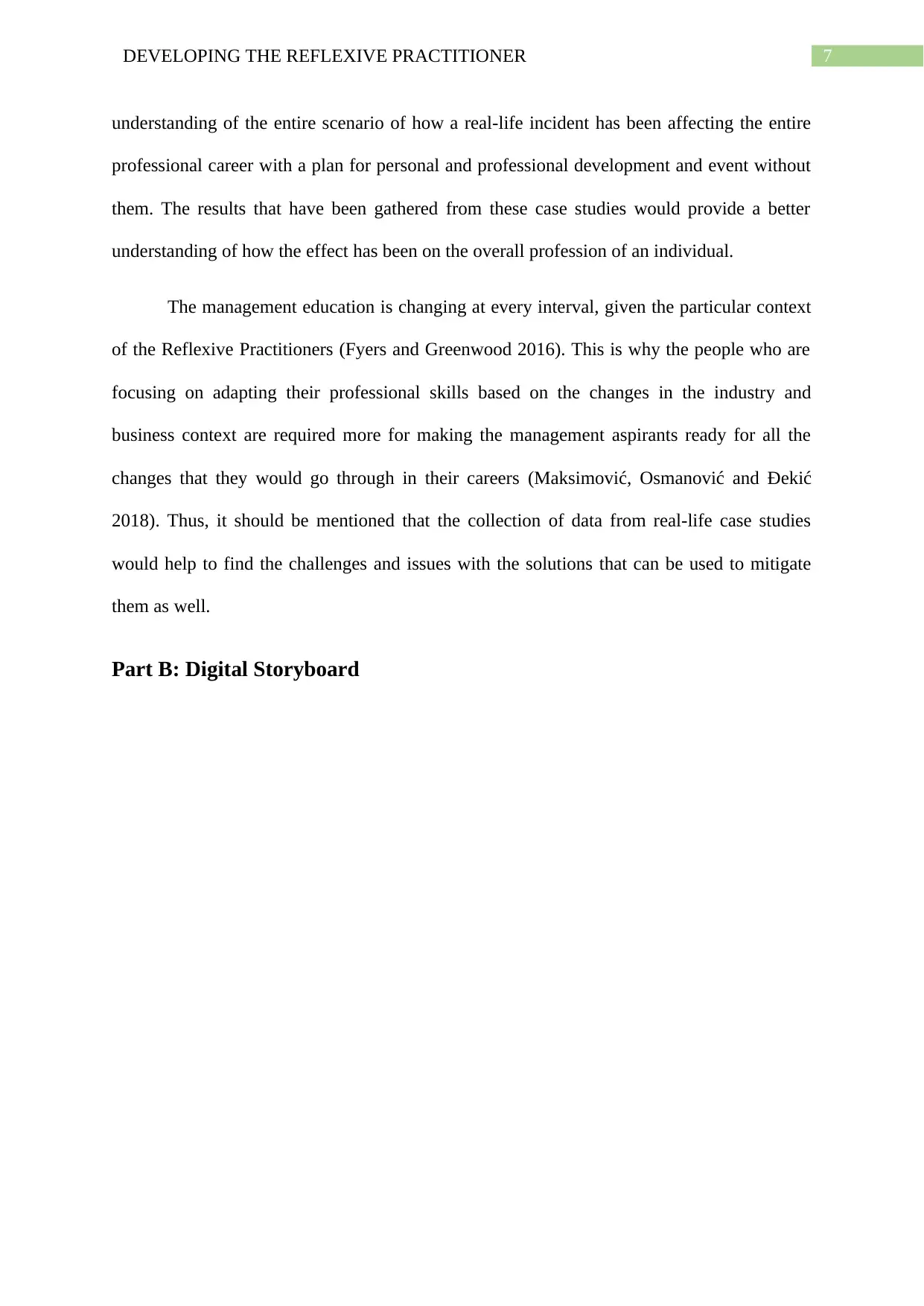
7DEVELOPING THE REFLEXIVE PRACTITIONER
understanding of the entire scenario of how a real-life incident has been affecting the entire
professional career with a plan for personal and professional development and event without
them. The results that have been gathered from these case studies would provide a better
understanding of how the effect has been on the overall profession of an individual.
The management education is changing at every interval, given the particular context
of the Reflexive Practitioners (Fyers and Greenwood 2016). This is why the people who are
focusing on adapting their professional skills based on the changes in the industry and
business context are required more for making the management aspirants ready for all the
changes that they would go through in their careers (Maksimović, Osmanović and Đekić
2018). Thus, it should be mentioned that the collection of data from real-life case studies
would help to find the challenges and issues with the solutions that can be used to mitigate
them as well.
Part B: Digital Storyboard
understanding of the entire scenario of how a real-life incident has been affecting the entire
professional career with a plan for personal and professional development and event without
them. The results that have been gathered from these case studies would provide a better
understanding of how the effect has been on the overall profession of an individual.
The management education is changing at every interval, given the particular context
of the Reflexive Practitioners (Fyers and Greenwood 2016). This is why the people who are
focusing on adapting their professional skills based on the changes in the industry and
business context are required more for making the management aspirants ready for all the
changes that they would go through in their careers (Maksimović, Osmanović and Đekić
2018). Thus, it should be mentioned that the collection of data from real-life case studies
would help to find the challenges and issues with the solutions that can be used to mitigate
them as well.
Part B: Digital Storyboard
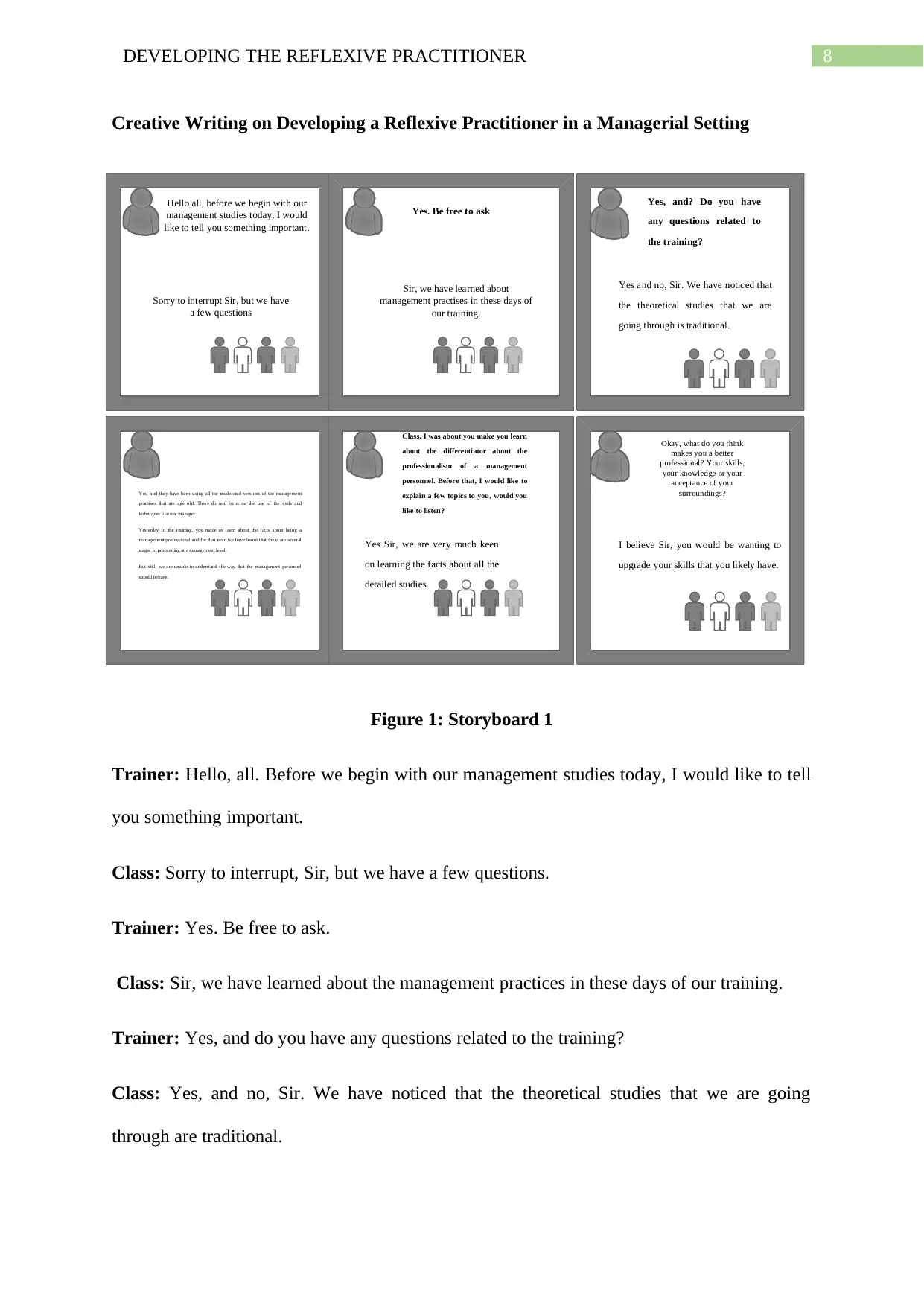
8DEVELOPING THE REFLEXIVE PRACTITIONER
Creative Writing on Developing a Reflexive Practitioner in a Managerial Setting
Figure 1: Storyboard 1
Trainer: Hello, all. Before we begin with our management studies today, I would like to tell
you something important.
Class: Sorry to interrupt, Sir, but we have a few questions.
Trainer: Yes. Be free to ask.
Class: Sir, we have learned about the management practices in these days of our training.
Trainer: Yes, and do you have any questions related to the training?
Class: Yes, and no, Sir. We have noticed that the theoretical studies that we are going
through are traditional.
Hello all, before we begin with our
management studies today, I would
like to tell you something important.
Sorry to interrupt Sir, but we have
a few questions
Yes. Be free to ask
Sir, we have learned about
management practises in these days of
our training.
Yes, and? Do you have
any questions related to
the training?
Yes and no, Sir. We have noticed that
the theoretical studies that we are
going through is traditional.
Yes, and they have been us ing all the moderated versions of the management
practises that are age old. Thes e do not focus on the use of the tools and
techniques like our manager.
Yesterday in the t raining, you made us learn about the facts about being a
management professional and for that even we have learnt that there are several
stages of proceeding at a management level.
But still, we are unable to understand the way that the management personnel
should behave.
Class, I was about you make you learn
about the differentiator about the
professionalism of a management
personnel. Before that, I would like to
explain a few topics to you, would you
like to listen?
Yes Sir, we are very much keen
on learning the facts about all the
detailed studies.
Okay, what do you think
makes you a better
professional? Your skills,
your knowledge or your
acceptance of your
surroundings?
I believe Sir, you would be wanting to
upgrade your skills that you likely have.
Creative Writing on Developing a Reflexive Practitioner in a Managerial Setting
Figure 1: Storyboard 1
Trainer: Hello, all. Before we begin with our management studies today, I would like to tell
you something important.
Class: Sorry to interrupt, Sir, but we have a few questions.
Trainer: Yes. Be free to ask.
Class: Sir, we have learned about the management practices in these days of our training.
Trainer: Yes, and do you have any questions related to the training?
Class: Yes, and no, Sir. We have noticed that the theoretical studies that we are going
through are traditional.
Hello all, before we begin with our
management studies today, I would
like to tell you something important.
Sorry to interrupt Sir, but we have
a few questions
Yes. Be free to ask
Sir, we have learned about
management practises in these days of
our training.
Yes, and? Do you have
any questions related to
the training?
Yes and no, Sir. We have noticed that
the theoretical studies that we are
going through is traditional.
Yes, and they have been us ing all the moderated versions of the management
practises that are age old. Thes e do not focus on the use of the tools and
techniques like our manager.
Yesterday in the t raining, you made us learn about the facts about being a
management professional and for that even we have learnt that there are several
stages of proceeding at a management level.
But still, we are unable to understand the way that the management personnel
should behave.
Class, I was about you make you learn
about the differentiator about the
professionalism of a management
personnel. Before that, I would like to
explain a few topics to you, would you
like to listen?
Yes Sir, we are very much keen
on learning the facts about all the
detailed studies.
Okay, what do you think
makes you a better
professional? Your skills,
your knowledge or your
acceptance of your
surroundings?
I believe Sir, you would be wanting to
upgrade your skills that you likely have.
⊘ This is a preview!⊘
Do you want full access?
Subscribe today to unlock all pages.

Trusted by 1+ million students worldwide
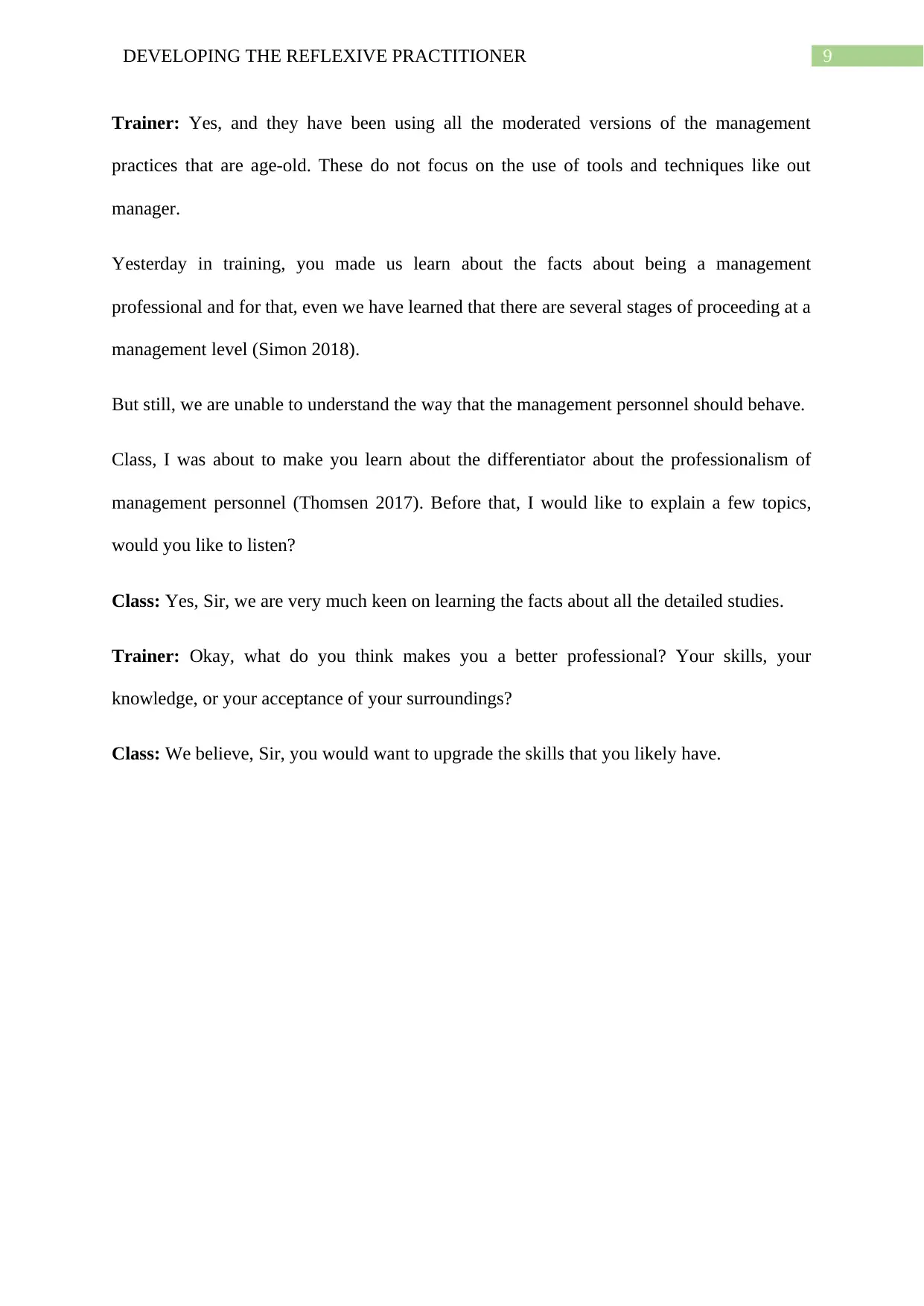
9DEVELOPING THE REFLEXIVE PRACTITIONER
Trainer: Yes, and they have been using all the moderated versions of the management
practices that are age-old. These do not focus on the use of tools and techniques like out
manager.
Yesterday in training, you made us learn about the facts about being a management
professional and for that, even we have learned that there are several stages of proceeding at a
management level (Simon 2018).
But still, we are unable to understand the way that the management personnel should behave.
Class, I was about to make you learn about the differentiator about the professionalism of
management personnel (Thomsen 2017). Before that, I would like to explain a few topics,
would you like to listen?
Class: Yes, Sir, we are very much keen on learning the facts about all the detailed studies.
Trainer: Okay, what do you think makes you a better professional? Your skills, your
knowledge, or your acceptance of your surroundings?
Class: We believe, Sir, you would want to upgrade the skills that you likely have.
Trainer: Yes, and they have been using all the moderated versions of the management
practices that are age-old. These do not focus on the use of tools and techniques like out
manager.
Yesterday in training, you made us learn about the facts about being a management
professional and for that, even we have learned that there are several stages of proceeding at a
management level (Simon 2018).
But still, we are unable to understand the way that the management personnel should behave.
Class, I was about to make you learn about the differentiator about the professionalism of
management personnel (Thomsen 2017). Before that, I would like to explain a few topics,
would you like to listen?
Class: Yes, Sir, we are very much keen on learning the facts about all the detailed studies.
Trainer: Okay, what do you think makes you a better professional? Your skills, your
knowledge, or your acceptance of your surroundings?
Class: We believe, Sir, you would want to upgrade the skills that you likely have.
Paraphrase This Document
Need a fresh take? Get an instant paraphrase of this document with our AI Paraphraser
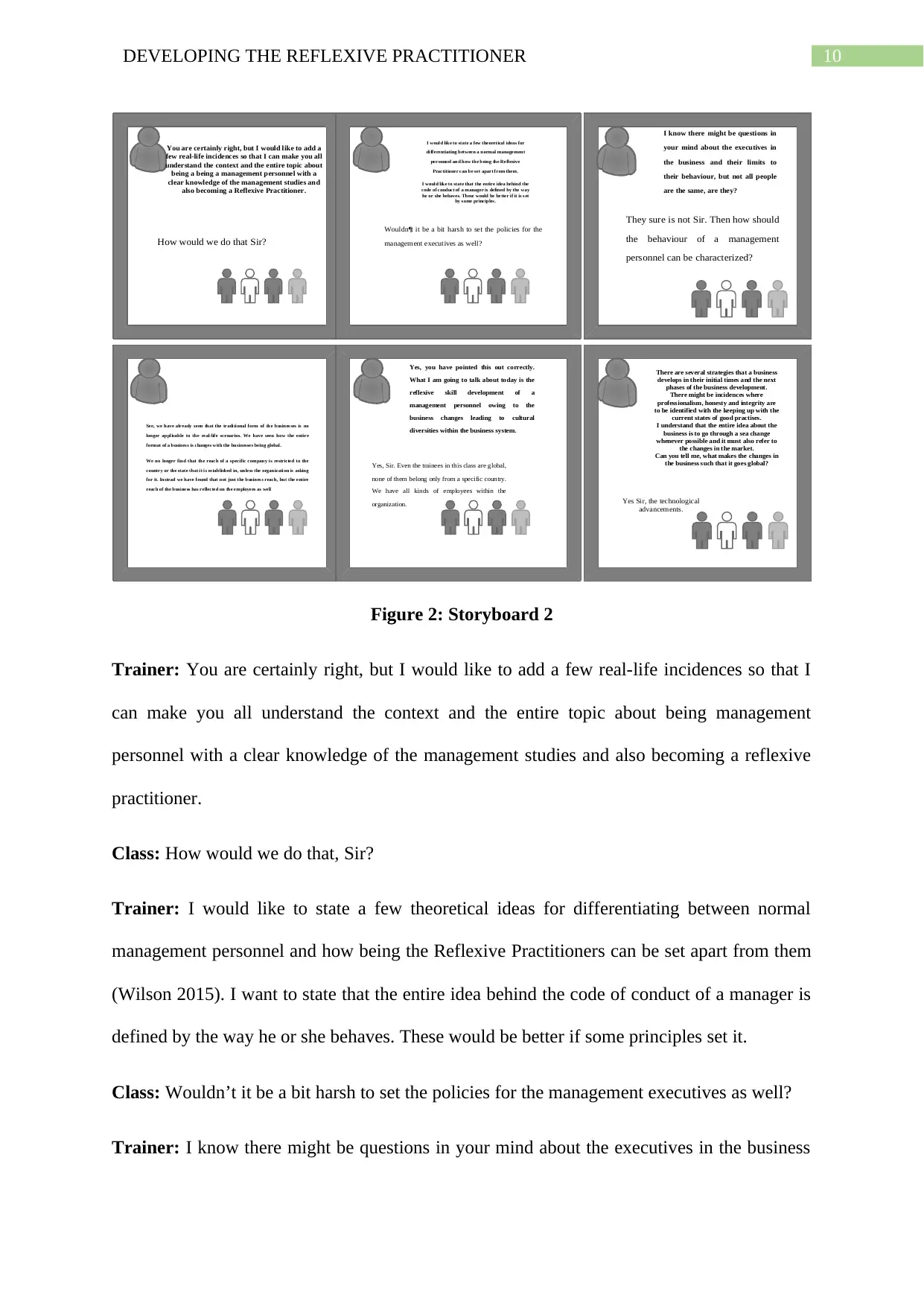
10DEVELOPING THE REFLEXIVE PRACTITIONER
Figure 2: Storyboard 2
Trainer: You are certainly right, but I would like to add a few real-life incidences so that I
can make you all understand the context and the entire topic about being management
personnel with a clear knowledge of the management studies and also becoming a reflexive
practitioner.
Class: How would we do that, Sir?
Trainer: I would like to state a few theoretical ideas for differentiating between normal
management personnel and how being the Reflexive Practitioners can be set apart from them
(Wilson 2015). I want to state that the entire idea behind the code of conduct of a manager is
defined by the way he or she behaves. These would be better if some principles set it.
Class: Wouldn’t it be a bit harsh to set the policies for the management executives as well?
Trainer: I know there might be questions in your mind about the executives in the business
You are certainly right, but I would like to add a
few real-life incidences so that I can make you all
understand the context and the entire topic about
being a being a management personnel with a
clear knowledge of the management studies and
also becoming a Reflexive Practitioner.
How would we do that Sir?
I woul d like to state a few theoretical ideas for
differentiating between a normal management
personnel and how the being the Reflexive
Practitioner can be set apart from them.
I woul d like to state that the entire idea behind the
code of conduct of a manager is defined by the way
he or she behaves. These would be be tter if it is s et
by some principles.
Wouldn¶t it be a bit harsh to set the policies for the
management executives as well?
I know there might be questions in
your mind about the executives in
the business and their limits to
their behaviour, but not all people
are the same, are they?
They sure is not Sir. Then how should
the behaviour of a management
personnel can be characterized?
See, we have already seen that the traditi onal form of the busines ses is no
longer appl icable to the real-life scenarios. We have seen how the entire
format of a busines s is changes with the businesses being global.
We no longer find that the reach of a specific company i s restricted to the
country or the state that i t i s established in, unless the organizati on is asking
for it. Instead we have found that not just the busines s reach, but the entire
reach of the busi ne ss has reflected on the employees as well
Yes, you have pointed this out correctly.
What I am going to talk about today is the
reflexive skill development of a
management personnel owing to the
business changes leading to cultural
diversities within the business system.
Yes, Sir. Even the trainees in this class are global,
none of them belong only from a specific country.
We have all kinds of employees within the
organization.
There are several strategies that a business
develops in their initial times and the next
phases of the business development.
There might be incidences where
professionalism, honesty and integrity are
to be identified with the keeping up with the
current states of good practises.
I understand that the entire idea about the
business is to go through a sea change
whenever possible and it must also refer to
the changes in the market.
Can you tell me, what makes the changes in
the business such that it goes global?
Yes Sir, the technological
advancements.
Figure 2: Storyboard 2
Trainer: You are certainly right, but I would like to add a few real-life incidences so that I
can make you all understand the context and the entire topic about being management
personnel with a clear knowledge of the management studies and also becoming a reflexive
practitioner.
Class: How would we do that, Sir?
Trainer: I would like to state a few theoretical ideas for differentiating between normal
management personnel and how being the Reflexive Practitioners can be set apart from them
(Wilson 2015). I want to state that the entire idea behind the code of conduct of a manager is
defined by the way he or she behaves. These would be better if some principles set it.
Class: Wouldn’t it be a bit harsh to set the policies for the management executives as well?
Trainer: I know there might be questions in your mind about the executives in the business
You are certainly right, but I would like to add a
few real-life incidences so that I can make you all
understand the context and the entire topic about
being a being a management personnel with a
clear knowledge of the management studies and
also becoming a Reflexive Practitioner.
How would we do that Sir?
I woul d like to state a few theoretical ideas for
differentiating between a normal management
personnel and how the being the Reflexive
Practitioner can be set apart from them.
I woul d like to state that the entire idea behind the
code of conduct of a manager is defined by the way
he or she behaves. These would be be tter if it is s et
by some principles.
Wouldn¶t it be a bit harsh to set the policies for the
management executives as well?
I know there might be questions in
your mind about the executives in
the business and their limits to
their behaviour, but not all people
are the same, are they?
They sure is not Sir. Then how should
the behaviour of a management
personnel can be characterized?
See, we have already seen that the traditi onal form of the busines ses is no
longer appl icable to the real-life scenarios. We have seen how the entire
format of a busines s is changes with the businesses being global.
We no longer find that the reach of a specific company i s restricted to the
country or the state that i t i s established in, unless the organizati on is asking
for it. Instead we have found that not just the busines s reach, but the entire
reach of the busi ne ss has reflected on the employees as well
Yes, you have pointed this out correctly.
What I am going to talk about today is the
reflexive skill development of a
management personnel owing to the
business changes leading to cultural
diversities within the business system.
Yes, Sir. Even the trainees in this class are global,
none of them belong only from a specific country.
We have all kinds of employees within the
organization.
There are several strategies that a business
develops in their initial times and the next
phases of the business development.
There might be incidences where
professionalism, honesty and integrity are
to be identified with the keeping up with the
current states of good practises.
I understand that the entire idea about the
business is to go through a sea change
whenever possible and it must also refer to
the changes in the market.
Can you tell me, what makes the changes in
the business such that it goes global?
Yes Sir, the technological
advancements.
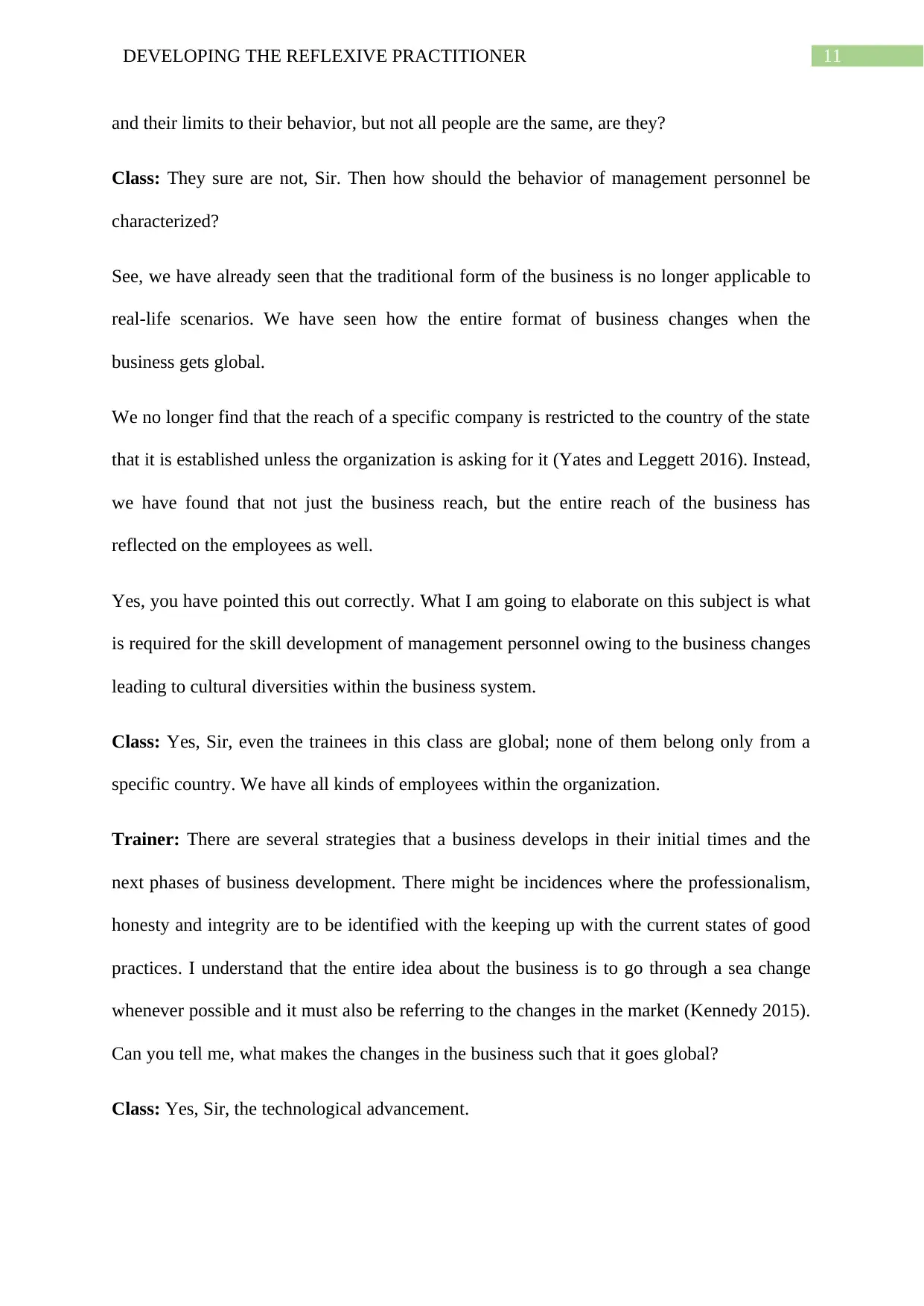
11DEVELOPING THE REFLEXIVE PRACTITIONER
and their limits to their behavior, but not all people are the same, are they?
Class: They sure are not, Sir. Then how should the behavior of management personnel be
characterized?
See, we have already seen that the traditional form of the business is no longer applicable to
real-life scenarios. We have seen how the entire format of business changes when the
business gets global.
We no longer find that the reach of a specific company is restricted to the country of the state
that it is established unless the organization is asking for it (Yates and Leggett 2016). Instead,
we have found that not just the business reach, but the entire reach of the business has
reflected on the employees as well.
Yes, you have pointed this out correctly. What I am going to elaborate on this subject is what
is required for the skill development of management personnel owing to the business changes
leading to cultural diversities within the business system.
Class: Yes, Sir, even the trainees in this class are global; none of them belong only from a
specific country. We have all kinds of employees within the organization.
Trainer: There are several strategies that a business develops in their initial times and the
next phases of business development. There might be incidences where the professionalism,
honesty and integrity are to be identified with the keeping up with the current states of good
practices. I understand that the entire idea about the business is to go through a sea change
whenever possible and it must also be referring to the changes in the market (Kennedy 2015).
Can you tell me, what makes the changes in the business such that it goes global?
Class: Yes, Sir, the technological advancement.
and their limits to their behavior, but not all people are the same, are they?
Class: They sure are not, Sir. Then how should the behavior of management personnel be
characterized?
See, we have already seen that the traditional form of the business is no longer applicable to
real-life scenarios. We have seen how the entire format of business changes when the
business gets global.
We no longer find that the reach of a specific company is restricted to the country of the state
that it is established unless the organization is asking for it (Yates and Leggett 2016). Instead,
we have found that not just the business reach, but the entire reach of the business has
reflected on the employees as well.
Yes, you have pointed this out correctly. What I am going to elaborate on this subject is what
is required for the skill development of management personnel owing to the business changes
leading to cultural diversities within the business system.
Class: Yes, Sir, even the trainees in this class are global; none of them belong only from a
specific country. We have all kinds of employees within the organization.
Trainer: There are several strategies that a business develops in their initial times and the
next phases of business development. There might be incidences where the professionalism,
honesty and integrity are to be identified with the keeping up with the current states of good
practices. I understand that the entire idea about the business is to go through a sea change
whenever possible and it must also be referring to the changes in the market (Kennedy 2015).
Can you tell me, what makes the changes in the business such that it goes global?
Class: Yes, Sir, the technological advancement.
⊘ This is a preview!⊘
Do you want full access?
Subscribe today to unlock all pages.

Trusted by 1+ million students worldwide
1 out of 17
Related Documents
Your All-in-One AI-Powered Toolkit for Academic Success.
+13062052269
info@desklib.com
Available 24*7 on WhatsApp / Email
![[object Object]](/_next/static/media/star-bottom.7253800d.svg)
Unlock your academic potential
Copyright © 2020–2025 A2Z Services. All Rights Reserved. Developed and managed by ZUCOL.





